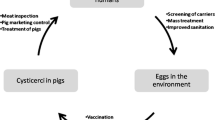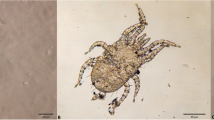Abstract
Parasites are among the most common pathogens recorded in dogs. High prevalence rates are usually reported in stray and shelter dogs, as these animals are less likely to be tested and treated. In this study a survey was carried out on intestinal and lung parasites of stray dogs at the moment of the admission in a shelter in Central Italy. In the period June 2014–June 2015, 262 individual faecal samples were examined. Twelve parasitic taxa were detected. Helminths were more prevalent than protozoa (61.8% and 25.6%, respectively). Ancylostomatidae showed the higher prevalence (40.5%), followed by Giardia duodenalis (21.4%), Toxocara canis (20.6%) and Trichuris vulpis (17.6%). Angiostrongylus vasorum was the most prevalent lungworm (12.6%), Crenosoma vulpis being recorded just in one dog. G. duodenalis had a high prevalence, probably because of the diagnostic techniques adopted, actually the most sensitive available for its detection. Nevertheless, the zoonotic potential of this parasite in dogs appears reduced, as all the isolates were identified as C (24.0%) and D (76.0%) dog specific assemblages. Taeniidae constituted a high potential zoonotic risk, as from the eggs it is impossible to exclude they were Echinococcus granulosus, the most relevant zoonotic parasite in Europe. The present study underline the importance of stray dogs control, aimed at preventing or minimizing parasitic spread and zoonotic transmission.
Similar content being viewed by others
References
Al-Sabi M.S.N., Kapel C.M.O., Johansson A., Espersen M.C., Koch J., Willesen J.L. 2013. A coprological investigation of gastrointestinal and cardiopulmonary parasites in hunting dogs in Denmark. Veterinary Parasitology, 196, 366–372. DOI: 10.1016/j.vetpar.2013.03.027
ASL ROMA 5, 2017. Accessed at https://www.aslroma5.info/web/ on 17/07/2017
Barutzki D., Schaper R. 2009. Natural infection of Angiostrongylus vasorum and Crenosoma vulpis in dogs in Germany. Parasitology Research, 105, 39–48. DOI: 10.1007/s00436-009-1494-x
Berrilli F., Di Cave D., De Liberato C., Franco A., Scaramozzino P., Orecchia P. 2004. Genotype characterisation of Giardia duodenalis isolates from domestic and farm animals by SSU-rRNA gene sequencing. Veterinary Parasitology, 122, 193–199. DOI: 10.1016/j.vetpar.2004.04.008
Bowman D.D. 1995. Georgi’s Parasitology for Veterinarians, 6th ed. (Ed.) W.B. Saunders Company, Philadelphia, 295–296
Capelli G., Frangipane di Regalbono A., Iorio R., Pietrobelli M., Paoletti B., Giangaspero A. 2006. Giardia species and other intestinal parasites in dogs in north-east and central Italy. Veterinary Record, 159, 422–424
Claerebout E., Casaert S., Dalemans A.C., De Wilde N., Levecke B., Vercruysse J., Geurden T. 2009. Giardia and other intestinal parasites in different dog populations in Northern Belgium. Veterinary Parasitology, 161, 41–46. DOI: 10.1016/j.vet-par.2008.11.024
Corine Land Cover. Carta Uso del Suolo della Regione Lazio, Accessed at http://dati.lazio.it/catalog/dataset/cus-lazio on 17 January 2017
Dakkak A. 2010. Echinococcosis/hydatidosis: A severe threat in Mediterranean countries. Veterinary Parasitology, 174, 2–11. DOI: 10.1016/j.vetpar.2010.08.009
De Liberato C., Mazzanti S., Scaramozzino P. 2009. First report of Eucoleus böhmi (Nematoda: Trichuroidea) from Italy: parasitological findings and veterinary implications. Parassitologia, 51, 43–45
Dopchiz M.C., Lavallén C.M., Bongiovanni R., Gonzalez P.V., Elissondo C., Yannarella F., Denegri G. 2013. Endoparasitic infections in dogs from rural areas in the Lobos District, Buenos Aires province, Argentina. Revista Brasileira de Parasitologia Veterinaria, 22, 92–97
Eleni C., De Liberato C., Azam D., Morgan E.R., Traversa D. 2013. Angiostrongylus vasorum in wolves in Italy. International Journal for Parasitology: Parasites and Wildlife, 3, 12–14. DOI: 10.1016/j.ijppaw.2013.10.003
Eleni C., Grifoni G., Di Egidio A., Meoli R., De Liberato C. 2014. Pathological findings of Angiostrongylus vasorum infection in red foxes (Vulpes vulpes) from central Italy, with the first report of a disseminated infection in this host species. Parasitology Research, 113, 1247–1250. DOI: 10.1007/s00436-014-3793-0
Epe C., Rehkter G., Schnieder T., Lorentzen L., Kreienbrock L. 2010. Giardia in symptomatic dogs and cats in Europe: results of a European study. Veterinary Parasitology, 173, 32–38. DOI: 10.1016/j.vetpar.2010.06.015
ESCCAP (European Scientific Counsel Companion Animal Parasites). 2010. Guideline No. 1. Worm Control in Dogs and Cats Second Edition. Accessed at https://doi.org/www.esccap.org/uploads/docs/nkzqxmxn_esccapgl1endoguidelines.pdf on 17 January 2017
Leitsch D. 2015. Drug resistance in the microaerophilic parasite Giardia lamblia. Current Tropical Medicine Reports, 2, 128–135. DOI: 10.1007/s40475-015-0051-1
Little S.E., Johnson E.M., Lewis D., Jaklitsch R.P., Payton M.E., Blagburn B.L., et al. 2009. Prevalence of intestinal parasites in pet dogs in the United States. Veterinary Parasitology, 166, 144–152. DOI: 10.1016/j.vetpar.2009.07.044.
Martins C.M., da Conceiçáo de Barros C., Bier D., Marinho A.P., Gonçalves Figueiredo J.M., Hoffmann J.L., Molento M.B., Biondo A.W. 2012. Dog parasite incidence and risk factors, from sampling after one-year interval, in Pinhais, Brazil. Revista Brasileira de Parasitologia Veterinaria, 21, 101–106
Mateus T.L., Castro A., Ribeiro J.N., Vieira-Pinto M. 2014. Multiple zoonotic parasites identified in dog feces collected in Ponte de Lima, Portugal–A potential threat to human health. International Journal of Environmental Research and Public Health, 11, 9050–9067. DOI: 10.3390/ijerph110909050
McGarry J.W., Morgan E.R. 2009. Identification of first-stage larvae of metastrongyles from dogs. Veterinary Record, 165, 258–261
Mirzaei M., Fooladi M. 2012. Prevalence of intestinal helminthes in owned dogs in Kerman city, Iran. Asian Pacific Journal of Tropical Medicine, 20, 735–737. DOI: 10.1016/S1995-7645(12)60116-3
Mohamed A.S., Moore G.E., Glickman L.T. 2009. Prevalence of intestinal nematode parasitism among pet dogs in the United States (2003–2006). Journal of the American Veterinary Medicine Association, 234, 631–637. DOI: 10.2460/javma.234.5.631
Nijsse R., Ploeger H.W., Wagenaar J.A., Mughini-Gras L. 2015. Toxocara canis in household dogs: prevalence, risk factors and owner’s attitude towards deworming. Parasitology Research, 114, 561–569. DOI: 10.1007/s00436-014-4218-9
Palmer C.S., Thompson R.C.A., Traub R.J., Rees R., Robertson I.D. 2008. National studies of the gastrointestinal parasites of dogs and cats in Australia. Veterinary Parasitology, 151, 181–190. DOI: 10.1016/j.vetpar.2007.10.015
Paoletti B., Traversa D., Iorio R., De Berardinis A., Bartolini R., Salini R., Di Cesare A. 2015. Zoonotic parasites in feces and fur of stray and private dogs from Italy. Parasitology Research, 114, 2135–2141. DOI: 10.1007/s00436-015-4402-6
Read C., Walters J., Robertson I.D., Thompson R.C.A. 2002. Correlation between genotype of Giardia duodenalis and diarrhoea. International Journal for Parasitology, 32, 229–231
Riggio F., Mannella R., Ariti G., Perrucci S. 2013. Intestinal and lung parasites in owned dogs and cats from central Italy. Veterinary Parasitology, 193, 78–84. DOI: 10.1016/j.vetpar.2012.11.026
Rinaldi L., Calabria G., Carbone S., Carrella A., Cringoli G. 2007. Crenosoma vulpis in dog: first case report in Italy and use of the FLOTAC technique for copromicroscopic diagnosis. Parasitology Research, 101, 1681–1684. DOI: 10.1007/s00436-007-0713-6
Sager H., Steiner Moret C., Grimm F., Deplazes P., Doherr M.G., Gottstein B. 2006. Coprological study of intestinal helminths in Swiss dogs: temporal aspects of anthelminthic treatment. Parasitology Research, 98, 333–338. DOI: 10.1007/s00436-005-0093-8
Scaramozzino P., Di Cave D., Berrilli B., D’Orazi C., Spaziani A., Mazzanti S., et al. 2009. A study of the prevalence and genotypes of Giardia duodenalis infecting kennelled dogs. Veterinary Journal, 182, 231–234. DOI: 10.1016/j.tvjl.2008.07.003
Simonato G., Frangipane di Regalbono A., Cassini R., Traversa D., Beraldo P., et al. 2015. Copromicroscopic and molecular investigations on intestinal parasites in kennelled dogs. Para-sitology Research, 114, 1963–1970. DOI: 10.1007/s00436-015-4385-3
Szwabe K., Błaszkowska J. 2017. Stray dogs and cats as potential sources of soil contamination with zoonotic parasites. Annals of Agriculture and Environmental Medicine, 24, 39–43. DOI: 10.5604/12321966.1234003
Taylor M.A., Coop R.L., Wall R.L. 2007. Veterinary Parasitology, 3rd edition. (Ed.) Blackwell Publishing, Oxford, UK
Traversa D., Di Cesare A., Conboy G. 2010. Canine and feline cardiopulmonary parasitic nematodes in Europe: emerging and underestimated. Parasites and Vectors, 3, 62–84. DOI: 10.1186/1756-3305-3-62
Traversa D., Di Cesare A., Simonato G., Cassini R., Merola C., Diakou A., et al. 2017. Zoonotic intestinal parasites and vector-borne pathogens in Italian shelter and kennel dogs. Comparative Immunology, Microbiology and Infectious Disease, 51, 69–75. DOI: 10.1016/j.cimid.2017.04.003
Upjohn M., Cobb C., Monger J., Geurden T., Claerebout E., Fox M. 2010. Prevalence, molecular typing and risk factor analysis for Giardia duodenalis infections in dogs in a central London rescue shelter. Veterinary Parasitology, 172, 341–346. DOI: 10.1016/j.vetpar.2010.05.010
Zajac A.M., Conboy G. 2012. Veterinary clinical parasitology. 8th edition. (Ed.) Wiley-Blackwell Publishing, Oxford, UK
Zanzani S.A., Gazzonis A.L., Scarpa P., Berrilli F., Manfredi M.T. 2014. Intestinal parasites of owned dogs and cats from metropolitan and micropolitan areas: prevalence, zoonotic risks and pet owner awareness in Northern Italy. BioMed Reseach International, 2014, 1–10. DOI: 10.1155/2014/696508
Author information
Authors and Affiliations
Corresponding author
Rights and permissions
About this article
Cite this article
De Liberato, C., Berrilli, F., Odorizi, L. et al. Parasites in stray dogs from Italy: prevalence, risk factors and management concerns. Acta Parasit. 63, 27–32 (2018). https://doi.org/10.1515/ap-2018-0003
Received:
Revised:
Accepted:
Published:
Issue Date:
DOI: https://doi.org/10.1515/ap-2018-0003




